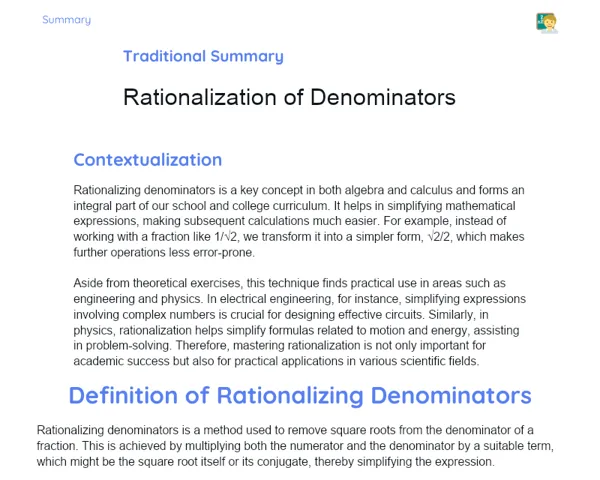Summary Tradisional | Rational Exponents: Powering
Contextualization
Exponents are a core mathematical operation encountered in many fields, ranging from physics to economics. Rational—or fractional—exponents extend the idea of integer exponents naturally. Grasping these is crucial as they enable conversion between powers and radicals, a key skill for tackling complex problems in mathematics, and for understanding advanced topics in algebra and calculus.
In our lesson today, we concentrated on converting powers with rational exponents to radicals, and vice versa. This isn’t just a theoretical exercise; it has practical implications in everyday scenarios. For instance, rational exponents are used in financial formulas to calculate compound interest and in physics to describe processes like radioactive decay. Understanding these operations will help you, our students, solve a variety of mathematical problems more effectively.
To Remember!
Concept of Rational Exponents
Rational exponents involve using fractional numbers as the exponent in a power operation. Unlike integer exponents that signify repeated multiplication of a base, rational exponents often indicate more intricate processes, such as involving roots. For example, 2^(1/2) denotes the square root of 2.
Think of the fraction m/n in a^(m/n) as a two-step operation: first, raise the base 'a' to the power m, and then take the n-th root of the result. This concept is foundational for progressing in various areas of mathematics, as it simplifies and allows us to manipulate complex expressions effectively.
Moreover, rational exponents find applications in various sectors, including financial and physical calculations. For instance, formulas for compound interest may use fractional exponents to determine how an investment grows over time.
-
Rational exponents use fractions as exponents.
-
They often involve operations with roots.
-
They help in simplifying and manipulating complex expressions.
Conversion of Powers into Radicals
Converting powers with rational exponents to radicals is an essential skill in mathematics. For instance, the expression a^(m/n) can be rewritten as n√(a^m), meaning that the base 'a' is raised to the power m first, followed by extracting the n-th root.
This conversion proves very helpful when simplifying expressions or solving equations that involve roots. An example is rewriting 8^(2/3) as the cube root of 8 squared, which simplifies neatly to 4, making it much easier to work with.
Understanding this conversion is also valuable in practical situations such as financial calculations, where switching between powers and radicals can assist in computing the future value of an investment under exponential growth.
-
The expression a^(m/n) can be converted into n√(a^m).
-
It helps simplify expressions and solve equations.
-
It is essential for practical problems, especially in financial computations.
Conversion of Radicals into Powers
Just as you can convert powers into radicals, radicals can also be expressed as powers with rational exponents. For example, the cube root of 5 can be represented as 5^(1/3). This conversion simplifies handling calculations and makes expression manipulation more manageable.
This technique is particularly useful in algebra and higher-level mathematics, where handling radicals is common. For instance, rewriting the square root of x^5 as (x^5)^(1/2) simplifies it to x^(5/2).
This skill is also widely applicable in subjects like physics and engineering, where square and cube roots are frequently encountered. A solid grasp of these conversions offers greater flexibility in solving complex problems.
-
Radicals can be converted into powers with rational exponents.
-
It simplifies calculations and the manipulation of expressions.
-
It is particularly useful in algebra and more advanced mathematical topics.
Properties of Exponentiation with Rational Exponents
Exponentiation with rational exponents adheres to several properties that build upon the rules for integer exponents. For example, when multiplying expressions with the same base, (a^(m/n)) * (a^(p/q)) equals a^((mq+np)/nq), which aids in simplifying complicated expressions.
Similarly, dividing powers with the same base, such as (a^(m/n)) / (a^(p/q)) yielding a^((mq-np)/nq), is a fundamental concept. Understanding these rules is critical when solving multi-step mathematical problems.
These properties are often combined with other operations to unravel and simplify equations that involve both powers and roots, streamlining problem-solving considerably.
-
Rules for multiplication and division of powers with rational exponents.
-
They help simplify complex expressions.
-
They are essential for solving multi-step mathematical problems.
Key Terms
-
Rational Exponents: Fractions used as exponents in power operations.
-
Conversion of Powers into Radicals: Rewriting an expression with a fractional exponent into its radical form.
-
Conversion of Radicals into Powers: Expressing a root as an expression with a fractional exponent.
-
Properties of Exponentiation: Rules that aid in simplifying and manipulating expressions with rational exponents.
Important Conclusions
In today’s lesson, we examined the key concepts of exponentiation with rational exponents, including converting powers into radicals and vice versa. These techniques allow for the simplification and effective manipulation of complex expressions, which is crucial for progressing in algebra and other areas of mathematics.
We also discussed the properties of exponentiation with rational exponents, such as the rules governing the multiplication and division of powers, and saw how these can be applied to practical scenarios. Mastery of these operations is not only important for academic success but also for real-world applications like financial and physical computations.
We encourage every student to keep practicing and exploring these concepts further, as a strong understanding here will serve as a solid foundation for more advanced studies and everyday problem-solving.
Study Tips
-
Practice converting powers into radicals and back with various examples to build confidence.
-
Solve exercises that focus on the properties of exponentiation with rational exponents to reinforce your understanding.
-
Explore how rational exponents apply in everyday contexts, such as in physics or economics, to appreciate their practical relevance.



